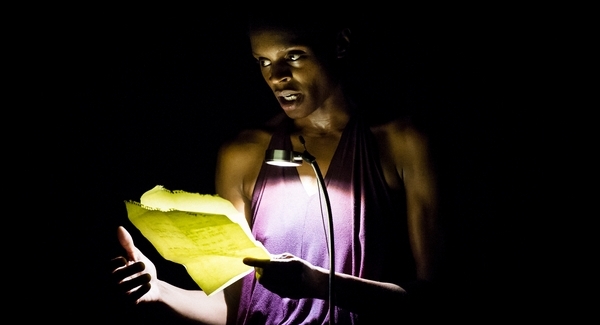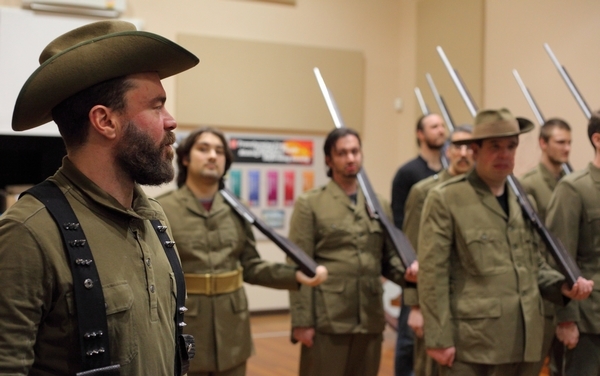The question is to do with the lived bodily experience of female adolescence. “It’s a story that is told with the body and in spoken language,” says Okpokwasili. “For me, absolutely at 11 or 12 and from my memories of the girls I was around, our bodies, my body, was like an alien to me. I didn’t get my period til I was 12; I knew some girls who got it at nine or ten. Even though I knew certain things were supposed to happen, it was still shocking. It felt so wrong. ‘How can I be bleeding? I should be dying.’ There is the possibility of marking things when you bleed; you’ve always got to check. I was irregular, so bleeding could come at any time, and I didn’t use tampons, I was using those pads; when I got my period I was in a panic; you have people check your back, because you can stain things. For me, at least, it was all sorts of weird. I feel that this is what adolescence is about. You’re thinking ‘What’s in here?’”
The beginning of Bronx Gothic in physical performance terms, Okpokwasili says, is a durational piece about that experience of one’s body becoming unknown. “It’s the internal trying to manifest, from memory, and from the process of the body morphing and shifting. I asked how I could replicate that in this piece. It’s a prelude, a pre-beginning where there’s a vibration, a quake, a generative vibration that’s continued every night; my body becomes unknowable. Afterwards I feel like I’ve shed a skin or something.” Okpokwasili says she doesn’t see herself as a singer although she says that song, along with dance and movement, is critical to the work. “The young girls sing to each other, it’s a way of trying to settle the self after something high has happened; they’re trying to shift the internal space a little bit,” she explains. In the way cats purr to soothe themselves when they’re stressed? “Kind of. The show toggles back and forth between states. The songs come out of the different states happening. I developed this work through a number of residencies – with each one I hooked onto different parts of the show to find out how the songs worked in this world.”
The story, in so far as there is a narrative, is also expressed via notes the girls exchange in class. “It’s an epistolary narrative told in the form of letters,” continues Okpokwasili. “As a child I read Jane Eyre, Bram Stoker; I interested myself in the Victorian Gothic era. I wanted to explore this form, to see how far I could go with exploring the relationship between the girls through notes. It’s a subterranean world, an unsupervised immediate place with notes passed under the nose of the teacher existing happily alongside the sanctioned world.” Do schoolgirls even pass each other notes anymore? “That might be kind of quaint now,” Okpokwasili says. “I can remember that and I want to explore that world.”
How important is the sense of place to Bronx Gothic, given that the Bronx is a singular area with such a well-known history? “I’m not doing an ethnographic study of the Bronx, and there isn’t so much of a Bronx veneer in the language, although someone said about the show that she heard a lot of slang from that time and era,” replies Okpokwasili. “There’s definitely a rhythm – it’s a kind of energetic pinging when the girls talk vocally to each other, a dynamic that I feel captures my memory of that time. There’s a mythology of the Bronx, with Fort Apache, The Bronx (a crime film set in the Bronx in the ’60s), and with the burning of the 1970s. After the burning of the buildings, questions were asked: Were the fires lit by rioters or were they lit by landlords who’d given up on the neighbourhood?”
The show is loosely set in the ’80s, but again, that doesn’t especially define the world that Okpokwasili creates on stage. “I’m playing in the terrain of memory. The era is slightly relevant. This space that I’m playing in is the space of memory and the unreliability of memory. I am trying to make something about girls becoming, about young women becoming, about how to hold and reconcile those memories. The girls are trying to find a way to function in a dynamic relationship.” Okpokwasili is quick to distance Bronx Gothic from alluding to any limited notion of adolescent ‘mean girls’. “I have to say I’m always afraid, instinctively nervous, about the idea of women and girls as inherently mean or competitive. The strongest, longest relationships I’ve had are with other women, they have sustained me through a lot of shit.”
BY LIZA DEZFOULI

